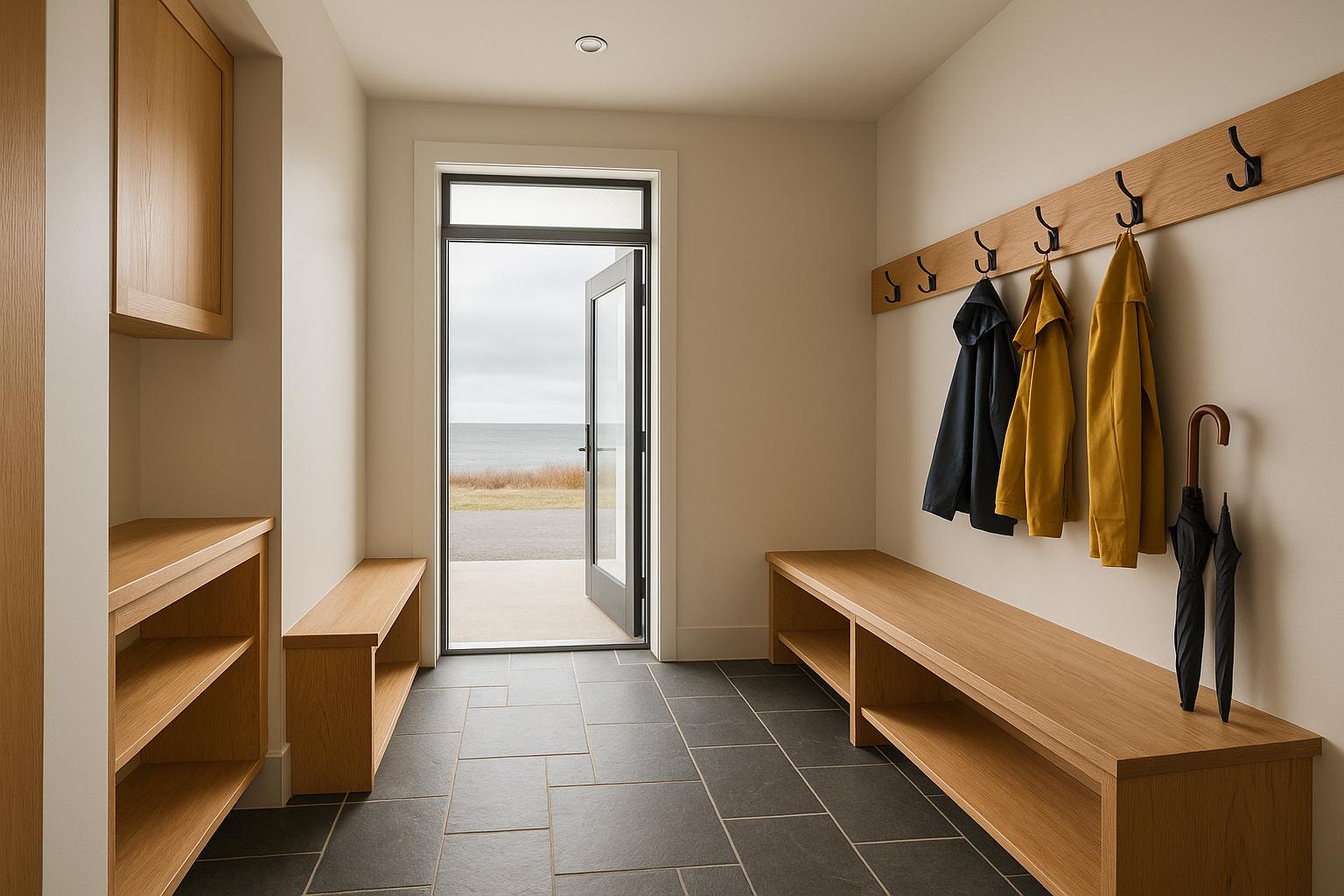Young Avenue in Halifax is a challenging area for property development due to its ER-2 zoning and strict heritage protection rules. While most of Halifax is easing regulations to boost housing supply, this historic street remains tightly regulated to preserve its character. Developers face limitations on density, building heights, and materials, along with lengthy approval processes. These restrictions often lead to higher costs, slower timelines, and lower investment returns compared to other areas.
Key points:
- ER-2 Zoning: Limits construction to single-unit homes, duplexes, and accessory dwelling units, with a maximum height of 11 metres.
- Heritage Rules: Require designs that align with the street's historic character, adding costs and delays.
- Investment Challenges: Lower density means fewer rental units and reduced returns compared to zones like HR-2 or Centre Areas, which allow taller buildings and higher density.
- Solutions: Developers can focus on interior conversions or adding accessory units to improve rental opportunities while staying compliant.
Young Avenue's unique restrictions demand careful planning and expertise to navigate effectively. While the rules protect its historic charm, they significantly limit development potential.
HALIFAX Home Owners May Have Just Won THE LOTTERY : Halifax Proposed Zoning Changes January 2024
ER-2 Zoning Rules and Heritage Protection Requirements
Young Avenue falls under the ER-2 zoning designation, which establishes basic building guidelines, along with heritage protection regulations that impose additional restrictions. To avoid setbacks like rejected applications, redesigns, or delays, developers must adhere to both frameworks.
Let’s break down the requirements for each.
What You Can Build Under ER-2 Zoning
ER-2 zoning in Halifax allows for single-unit homes, duplexes, and accessory dwelling units on eligible properties. Unlike zones permitting larger multifamily developments, ER-2 prioritizes a smaller, neighbourhood-oriented feel.
This zoning framework includes rules for minimum lot size and frontage, limits on how much of the land can be built upon, and height restrictions to ensure new developments blend with the surrounding area. Additional regulations, like setback requirements and guidelines for accessory dwelling units, further shape what’s possible within these limits.
Heritage Rules and Building Restrictions
While ER-2 zoning sets the groundwork, heritage rules introduce another layer of oversight, particularly on Young Avenue. These rules require design reviews that go beyond standard zoning compliance, with the Halifax Heritage Advisory Committee overseeing approvals for any exterior changes, new builds, or even minor updates.
Heritage regulations focus heavily on preserving the neighbourhood's historic character. This often means using specific materials or design elements that can be more expensive. The approval process can take longer, and even interior changes - such as converting a single-family home into a duplex - must retain the property’s historical integrity. Even seemingly minor exterior updates need to match the original architectural style.
Young Avenue's Additional Zoning Rules
In addition to ER-2 and heritage requirements, Young Avenue has its own set of area-specific rules aimed at addressing local priorities and preserving its historical charm.
These additional regulations include stricter parking requirements, tree preservation mandates, and on-site stormwater management measures. For instance, corner lots may have enhanced setback requirements, while stormwater rules might call for features like rain gardens or permeable paving to handle runoff. These measures not only add complexity to development plans but also increase long-term maintenance needs.
Combined, these layered rules significantly limit how densely properties can be developed. Navigating these constraints often requires creative planning or exploring alternative approaches to meet investment goals while staying within the regulatory boundaries.
Real Problems Property Owners Face with ER-2 and Heritage Rules
Property owners on Young Avenue face real challenges due to ER-2 zoning and heritage rules, which limit building potential and impact long-term investment returns. The restrictions become clear when comparing the density allowances of ER-2 with other zoning types.
How Density Limits Impact Investment Returns
Under ER-2 zoning, buildings can only reach a maximum height of 11 metres (around three storeys). This restriction means fewer rental units can be built, which directly reduces cumulative income and overall investment returns. While it’s possible to convert larger homes into multiple units or add backyard suites within this zoning, other zones like HR-2 and Centre Areas allow for much higher densities with taller buildings, making them more appealing for investors.
Heritage Review: Delays and Added Costs
Heritage rules add another layer of complexity. Any exterior changes must go through the Halifax Heritage Advisory Committee, which can significantly extend project timelines. On top of that, these rules often require expensive, specialized materials and designs, further complicating cash flow and cutting into potential returns.
ER-2 vs Other Zoning Types: A Direct Comparison
Here’s a quick breakdown of how ER-2 zoning stacks up against other types:
| Zone Type | Maximum Building Height/Storeys | Density Potential |
|---|---|---|
| ER-2 | Up to 11 metres (approximately 3 storeys) | Lower – typically limited to converting homes or adding suites |
| ER-3 | Up to 12 metres (approximately 3 storeys) | Moderate – permits development of up to 8 units |
| HR-2 | Up to 9 storeys | Higher – ideal for areas near universities with greater unit potential |
| Centre Areas | Up to 40 storeys | Maximum – supports significantly higher density |
The trade-off with ER-2 zoning is clear: while it helps preserve the historic charm of Young Avenue, it limits rental income and investment opportunities. For developers, these restrictions are a critical factor to weigh when considering projects in the area.
How to Maximize Returns Within Zoning and Heritage Limits
Navigating ER-2 and heritage restrictions can feel like a challenge, but with the right strategies, property owners can still find ways to improve their return on investment (ROI). The key lies in creative and compliant project planning.
Development Options That Work Within the Rules
To respect heritage guidelines while increasing property value, focus on projects that enhance existing spaces. For example, converting the interior of a heritage home into multiple units or adding accessory dwelling units (ADUs) can increase rental opportunities without altering the building's historic character. These strategies allow for growth while staying within the boundaries of zoning and heritage requirements.
Navigating Heritage and Zoning Approvals
Getting approval for your project starts with early engagement. Present preliminary designs to Halifax's Heritage Advisory Committee to address potential issues before they escalate into costly delays. Partnering with architects who specialize in heritage properties can also help ensure your plans align with ER-2 zoning rules. Additionally, scheduling pre-application meetings with municipal planners can clarify requirements and reduce risks, keeping the process smoother and more predictable.
Boosting ROI Within Restrictions
To attract tenants and increase rental income, focus on upgrades that add value. Premium finishes and energy-efficient features are great examples. In Halifax, well-finished two-bedroom units often rent for $1,950 to $2,100 per month. Energy-efficient financing programs, which offer up to 95% financing with extended amortization, can offset higher construction costs and improve cash flow. Adding smart home technology and modern appliances can also make your property more appealing in a competitive market.
Simplifying Construction with an Integrated Approach
For heritage projects, managing design, engineering, and construction as a single, integrated process can save time and money. This approach avoids the headaches of coordinating multiple contractors and ensures timelines and budgets stay on track. With everything under one roof, you can streamline your project and focus on maximizing your returns.
sbb-itb-16b8a48
Integrated Construction for Young Avenue Projects
When working on properties with ER-2 zoning and heritage restrictions on Young Avenue, the construction method you choose can significantly impact your project's success. These regulations are complex, demanding a more coordinated approach than traditional methods. This is where integrated construction offers a distinct advantage.
Traditional Construction vs Integrated Construction
Traditional construction often requires property owners to juggle multiple contracts with architects, engineers, heritage consultants, and general contractors. This fragmented process frequently leads to miscommunication, disputes, and budget overruns ranging from 30–60%. Timelines can also spiral out of control, stretching from 8 months to over 18 months.
In contrast, integrated construction brings design, engineering, and construction teams together under one umbrella. This method significantly reduces delays and cost increases. On average, property owners save about $47,000 in coordination costs compared to traditional methods. Additionally, avoiding delays is critical - each month of delay can mean roughly $8,800 in lost rental income for a standard fourplex.
How Helio Urban Development Handles These Projects

Helio Urban Development takes integrated construction to the next level for Young Avenue projects. Navigating the strict ER-2 zoning and heritage restrictions, Helio's method ensures compliance while streamlining the entire process. As Nova Scotia’s only integrated design-build company specializing in 4+ unit rental properties, Helio eliminates common issues like coordination breakdowns, budget overruns, and extended timelines.
The process starts with early heritage consultation. Helio’s architects collaborate with heritage specialists from the beginning, avoiding costly redesigns and keeping projects on track.
Helio’s pricing is transparent and reliable, with construction costs set at $160,000 per unit and no budget overruns on completed projects. This cost certainty is especially critical for heritage properties, where unforeseen challenges are common.
Timelines are another area where Helio stands out. They guarantee a 6-month construction period, with penalties of up to $1,000 per day for delays - far better than the industry average of 12–18 months. According to co-founder Lloyd Liu, "I personally guarantee every timeline because I've felt the pain of construction delays."
To ensure quality, Helio employs a triple verification system. This includes five inspections by P.Eng-certified engineers during construction, along with a final inspection chosen by the property owner. The result is bank-grade quality, backed by a 2-year warranty on all work.
For properties eligible for CMHC MLI Select financing, Helio offers construction at $200,000 per unit, meeting higher energy efficiency standards. This allows property owners to secure up to 95% financing with a 50-year amortization, improving cash flow even with the higher upfront cost.
Currently, Helio has 31 units under construction across Nova Scotia, with 131 more in the planning stages. They serve property owners within a 90-minute radius of Halifax, achieving zero coordination disputes - a stark contrast to the challenges of traditional construction.
Helio also provides daily photo updates through a dedicated portal, ensuring transparency and helping to avoid delays that often plague heritage projects. This level of efficiency makes integrated construction an excellent choice for Young Avenue properties, where heritage compliance adds complexity to every step of development.
Conclusion: Building Successfully on Young Avenue
What Property Owners Need to Know
Young Avenue presents a unique set of challenges for property owners, thanks to its ER-2 zoning and heritage protection regulations. These restrictions may seem daunting, but they don’t eliminate opportunities - they just require careful navigation. The first step? Understanding the rules before you begin planning.
As a designated "Special Area" under Halifax's Centre Plan, Young Avenue is subject to strict guidelines, including specific lot sizes, frontage requirements, coverage limits, and an 11-metre height cap [3]. Ignoring these rules can lead to costly delays and unexpected expenses [1][2][3].
Successful property owners on Young Avenue don’t try to sidestep the regulations - they work within them. While the density limits may restrict the number of units, the preserved heritage character adds value to the neighbourhood, often enhancing rental demand and justifying the constraints.
Why Expert Help Matters for These Projects
Navigating the intricate web of zoning and heritage rules on Young Avenue requires precision and expertise. Missteps can lead to conflicts with residents or municipal planners, so it’s crucial to get it right the first time [1][2].
Collaborating with builders who have a deep understanding of Halifax’s unique zoning and heritage regulations is essential. Strategies that work elsewhere might fail here, making local expertise invaluable [3]. A well-rounded approach - integrating environmental planning, design, construction, and heritage conservation - can help you tackle these challenges effectively [4].
FAQs
What challenges do property owners face when trying to develop multi-unit housing on Young Avenue under ER-2 zoning and heritage rules?
Challenges for Multi-Unit Housing Development on Young Avenue
Developing multi-unit housing on Young Avenue comes with its fair share of challenges, largely due to ER-2 zoning regulations and heritage protection rules. Under ER-2 zoning, property owners are typically allowed up to two main dwelling units and one backyard suite. However, heritage designations can complicate things significantly. These rules often impose strict limits on demolitions, alterations, and new construction, making it tough to increase housing density.
To work within these constraints, property owners often need to go through heritage assessments, engage in negotiations, and adhere to rigorous preservation standards. These steps can be time-consuming and create a sense of uncertainty, especially when trying to balance compliance with profitability. For those looking to develop on Young Avenue, understanding these regulations and finding creative ways to work within them is key to navigating the process effectively.
What strategies can property owners on Young Avenue use to increase their ROI while complying with zoning and heritage regulations?
Property owners on Young Avenue can increase their return on investment by planning projects that respect ER-2 zoning rules and heritage preservation guidelines. Working closely with heritage advisory committees can lead to creative designs that honour the neighbourhood's character while maximizing density within the allowed limits.
To make this work, consider streamlined construction methods that offer single-contract accountability and reduce risks. Careful planning and designs that meet regulatory requirements can strike a balance between preserving the area's charm and achieving investment goals, helping property owners navigate the unique constraints of the neighbourhood effectively.
What are the benefits of using an integrated construction approach for heritage-sensitive projects on Young Avenue in Halifax?
The Benefits of an Integrated Construction Approach
Taking an integrated construction approach can be a game-changer for heritage-sensitive projects on Young Avenue. By merging the design and construction phases into one cohesive process, this method helps eliminate common issues like delays, miscommunication, and coordination challenges often found in traditional construction methods. Plus, it works well with fixed-price contracts, giving property owners more confidence in managing their budgets.
When dealing with areas under heritage protections, having an integrated team becomes even more valuable. Designers, builders, and other stakeholders can collaborate closely, ensuring the project aligns with regulations while still reaching its full potential. This approach helps navigate restrictions more smoothly, making it ideal for multi-unit residential developments in heritage-sensitive zones. The result? A streamlined process that saves time, reduces risks, and keeps things running efficiently.



